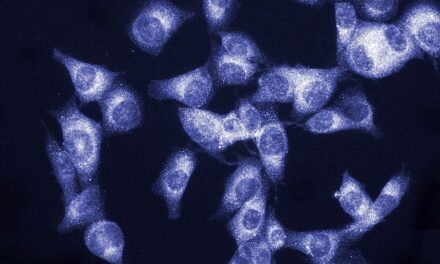Research published by Oncotarget has identified urine protein biomarkers of bladder cancer. The study, “Urine protein biomarkers of bladder cancer arising from 16-plex antibody-based screens,” examined urine samples from 66 subjects, comprising of 31 urology clinic controls and 35 bladder cancer patients, using a Luminex based screening platform.
ELISA validation was carried out for the top four prospective urine biomarkers using an independent cohort of 20 urology clinic controls and 60 bladder cancer subjects.
Eight of these urine proteins were able to differentiate BC from control urine with ROC AUC values exceeding 0.70 at p < 0.0001, with specificity values exceeding 0.9. Upon ELISA validation, urine IL-1α, IL-1ra, and IL-8 were able to distinguish control urine from urine drawn from various bladder cancer stages, with IL-8 being the best discriminator.
These findings suggest that urine IL-1α, IL-1ra and IL-8 are useful indicators of bladder cancer, according to the researchers.
Distinguishing High-Grade from Low-Grade Disease
Urine IL-8 not only distinguishes bladder cancer from controls, it also discriminates high-grade from low-grade disease, and the successive clinical stages of bladder cancer.
Chandra Mohan from The University of Houston, MD, PhD, says, “Bladder cancer (BC) is the sixth most common cancer diagnosis in the United States and is over four times more common in men than women.“
Urine biomarkers could potentially provide preliminary confirmation of low-grade BC before invasive procedures are performed and facilitate surveillance of BC, as reviewed.
The present study implements a Luminex based screening platform with a cytokine/chemokine panel that simultaneously interrogates 16 urine biomarkers, followed by ELISA validation of 4 prospective urine biomarkers.
Of the 16 proteins screened by Luminex, 12 were within the detectable range and among these, 10 urine biomarkers showed significant elevation in BC compared to the controls.
ELISA validation for these 4 urine biomarkers was carried out using an independent cohort of 20 urology clinic controls and 60 BC subjects.
Of these 4 proteins, IL-8 displayed the highest significance in discriminating between controls and BC patients and discriminating highly advanced stages/grades of BC from less advanced stages/grades of BC.
Diagnostic Potential
The Mohan Research Team concluded in their Oncotarget Research Output that these studies indicate that urine IL-1α, IL-1ra, and IL-8 are potential biomarkers of BC, two of which re-affirm previous reports.
These studies shed additional light on the potential utility of these markers, since some of them also exhibit the ability to discriminate T1 and/or T2-T4 from Ta BC, as well as high grade from low grade BC.
Looking forward, systematic studies in larger patient cohorts are warranted to establish the specific clinical contexts in which these markers may be used, including the following: for initial diagnosis of BC, for surveillance of tumor recurrence, and/or for assessing treatment response following BCG therapy or other therapeutic modalities.
Finally, these newer urine biomarkers need to be compared against the performance of current yardsticks such as the Bladderchek and UroVysion FISH assay.





